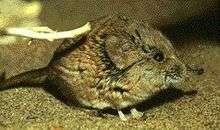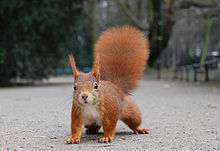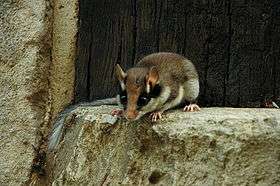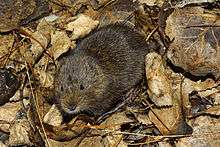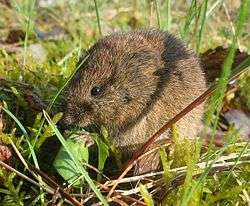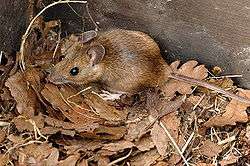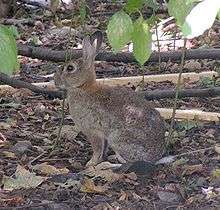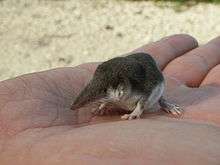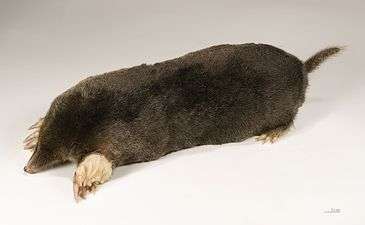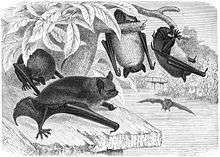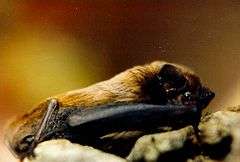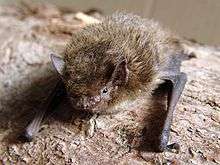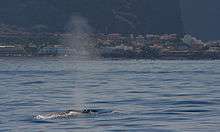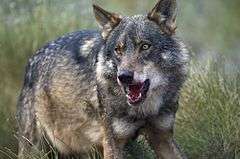List of mammals of Spain

This is a list of the mammal species recorded in Spain. There are 115 mammal species in Spain, of which 2 are critically endangered, 5 are endangered, 13 are vulnerable, and 3 are close-threatened.[1] The list includes mammals from every Spanish territory, both in and outside the Iberian Peninsula; for mammals found only in extra-peninsular territories see List of mammals of the Balearic Islands, List of mammals of the Canary Islands and List of mammals of Ceuta, Melilla and the Plazas de Soberanía.
The following tags are used to highlight each species' conservation status as assessed by the IUCN. If the IUCN status of a species in Spain only is different from its global status,[2] the status in Spain is shown next between brackets:
| EX | Extinct | No reasonable doubt that the last individual has died. |
| EW | Extinct in the wild | Known only to survive in captivity or as a naturalized populations well outside its previous range. |
| CR | Critically endangered | The species is in imminent risk of extinction in the wild. |
| EN | Endangered | The species is facing an extremely high risk of extinction in the wild. |
| VU | Vulnerable | The species is facing a high risk of extinction in the wild. |
| NT | Near threatened | The species does not meet any of the criteria that would categorise it as risking extinction but it is likely to do so in the future. |
| LC | Least concern | There are no current identifiable risks to the species. |
| DD | Data deficient | There is inadequate information to make an assessment of the risks to this species. |
Some species were assessed using an earlier set of criteria. Species assessed using this system have the following instead of near threatened and least concern categories:
| LR/cd | Lower risk/conservation dependent | Species which were the focus of conservation programmes and may have moved into a higher risk category if that programme was discontinued. |
| LR/nt | Lower risk/near threatened | Species which are close to being classified as vulnerable but are not the subject of conservation programmes. |
| LR/lc | Lower risk/least concern | Species for which there are no identifiable risks. |
Subclass: Theria
Infraclass: Eutheria
Order: Macroscelidea (elephant shrews)
Elephant shrews are small insectivorous mammals native to Africa and members of the superorder Afrotheria. Their name derives from their elongated noses resembling the trunks of elephants, to whom they are distantly related.
- Family: Macroscelididae
- Genus: Elephantulus
- North African elephant shrew Elephantulus rozeti LC
- Genus: Elephantulus
Order: Rodentia (rodents)
Rodents make up the largest order of mammals, with over 40 percent of mammalian species. They have two incisors in the upper and lower jaw which grow continually and must be keep short by gnawing. Most rodents are small though the capybara can weigh up to 45 kg (100 lb).
- Suborder: Castorimorpha
- Family: Castoridae (beavers)
- Subfamily: Castorinae
- Tribe: Castorini
- Genus: Castor
- Eurasian beaver Castor fiber LC[3][4]
- Genus: Castor
- Tribe: Castorini
- Subfamily: Castorinae
- Family: Castoridae (beavers)
- Suborder: Hystricomorpha
- Infraorder: Hystricognathi
- Family: Hystricidae (old world porcupines)
- Subfamily: Hystricinae
- Genus: Hystrix
- Crested porcupine Hystrix cristata LC
- Genus: Hystrix
- Subfamily: Hystricinae
- Family: Hystricidae (old world porcupines)
- Family: Myocastoridae (coypu)
- Infraorder: Hystricognathi
- Suborder: Sciurognathi
- Family: Sciuridae (squirrels)
- Subfamily: Sciurinae
- Tribe: Sciurini
- Genus: Sciurus
- Red squirrel Sciurus vulgaris NT
- Genus: Sciurus
- Tribe: Sciurini
- Subfamily: Xerinae
- Tribe: Marmotini
- Genus: Marmota
- Alpine marmot Marmota marmota LR/lc
- Genus: Marmota
- Tribe: Xerini
- Genus: Atlantoxerus
- Barbary ground squirrel Atlantoxerus getulus LR/lc (introduced)
- Genus: Atlantoxerus
- Tribe: Marmotini
- Subfamily: Sciurinae
- Family: Gliridae (dormice)
- Subfamily: Leithiinae
- Genus: Eliomys
- Maghreb garden dormouse Eliomys munbyanus LC
- Garden dormouse Eliomys quercinus VU
- Genus: Eliomys
- Subfamily: Glirinae
- Genus: Glis
- Edible dormouse Glis glis LR/nt
- Genus: Glis
- Subfamily: Leithiinae
- Family: Sciuridae (squirrels)
- Suborder: Myomorpha
- Family: Cricetidae (hamsters, voles, lemmings)
- Subfamily: Arvicolinae
- Genus: Arvicola
- Southwestern water vole Arvicola sapidus LR/nt (VU)
- Water vole Arvicola terrestris LR/lc
- Genus: Chionomys
- Snow vole Chionomys nivalis LR/nt (NT)
- Genus: Microtus
- Field vole Microtus agrestis LR/lc
- Common vole Microtus arvalis LR/lc
- Cabrera's vole Microtus cabrerae LR/nt (VU)
- Mediterranean pine vole Microtus duodecimcostatus LR/lc
- Gerbe's vole Microtus gerbei LR/lc
- Lusitanian pine vole Microtus lusitanicus LR/lc
- Genus: Myodes
- Bank vole Myodes glareolus LR/lc
- Genus: Ondatra
- Muskrat Ondatra zibethicus LR/lc (introduced)
- Genus: Arvicola
- Subfamily: Arvicolinae
- Family: Muridae (mice and rats)
- Subfamily: Gerbillinae
- Genus: Dipodillus
- North African gerbil Dipodillus campestris LC
- Genus: Dipodillus
- Subfamily: Murinae
- Genus: Apodemus
- Yellow-necked mouse Apodemus flavicollis LR/lc
- Wood mouse Apodemus sylvaticus LC
- Genus: Lemniscomys
- Barbary striped grass mouse Lemniscomys barbarus LC
- Genus: Micromys
- Harvest mouse Micromys minutus LR/nt
- Genus: Mus
- House mouse Mus musculus LR/lc
- Algerian mouse Mus spretus LC
- Genus: Rattus
- Genus: Apodemus
- Subfamily: Gerbillinae
- Family: Cricetidae (hamsters, voles, lemmings)
Order: Lagomorpha (lagomorphs)
The lagomorphs comprise two families, Leporidae (hares and rabbits), and Ochotonidae (pikas). Though they can resemble rodents, and were classified as a superfamily in that order until the early 20th century, they have since been considered a separate order. They differ from rodents in a number of physical characteristics, such as having four incisors in the upper jaw rather than two.
- Family: Leporidae (rabbits, hares)
- Genus: Oryctolagus
- European rabbit Oryctolagus cuniculus LR/lc (VU)
- Genus: Lepus
- Broom hare Lepus castroviejoi VU
- Maghrebi hare Lepus (capensis) schlumbergeri LR/lc
- European hare Lepus europaeus LR/lc
- Granada hare Lepus granatensis LR/lc
- Genus: Oryctolagus
Order: Erinaceomorpha (hedgehogs and gymnures)
The order Erinaceomorpha contains a single family, Erinaceidae, which comprise the hedgehogs and gymnures. The hedgehogs are easily recognised by their spines while gymnures look more like large rats.
- Family: Erinaceidae (hedgehogs)
- Subfamily: Erinaceinae
- Genus: Atelerix
- North African hedgehog Atelerix algirus LR/lc
- Genus: Erinaceus
- West European hedgehog Erinaceus europaeus LR/lc
- Genus: Atelerix
- Subfamily: Erinaceinae
Order: Soricomorpha (shrews, moles, and solenodons)
The "shrew-forms" are insectivorous mammals. The shrews and solenodons closely resemble mice while the moles are stout bodied burrowers.
- Family: Soricidae (shrews)
- Subfamily: Crocidurinae
- Genus: Crocidura
- Canary shrew Crocidura canariensis VU
- North African white-toothed shrew Crocidura ichnusae LC (introduced)
- Greater white-toothed shrew Crocidura russula LC
- Lesser white-toothed shrew Crocidura suaveolens LC
- Whitaker's shrew Crocidura whitakeri LC
- Genus: Suncus
- Etruscan shrew Suncus etruscus LC
- Genus: Crocidura
- Subfamily: Soricinae
- Tribe: Nectogalini
- Genus: Neomys
- Southern water shrew Neomys anomalus LR/lc
- Eurasian water shrew Neomys fodiens LR/lc
- Genus: Neomys
- Tribe: Soricini
- Genus: Sorex
- Alpine shrew Sorex alpinus LR/lc (EX)[5]
- Common shrew Sorex araneus LR/lc
- Crowned shrew Sorex coronatus LR/lc
- Iberian shrew Sorex granarius LR/lc
- Eurasian pygmy shrew Sorex minutus LR/lc
- Genus: Sorex
- Tribe: Nectogalini
- Subfamily: Crocidurinae
- Family: Talpidae (moles)
- Subfamily: Talpinae
- Tribe: Desmanini
- Genus: Galemys
- Pyrenean desman Galemys pyrenaicus VU
- Genus: Galemys
- Tribe: Talpini
- Genus: Talpa (genus)
- European mole Talpa europaea LR/lc
- Iberian mole Talpa occidentalis LR/lc
- Genus: Talpa (genus)
- Tribe: Desmanini
- Subfamily: Talpinae
Order: Chiroptera (bats)
The bats' most distinguishing feature is that their forelimbs are developed as wings, making them the only mammals in the world naturally capable of flight. Bat species account for about 20% of all mammals.
- Suborder: Megachiroptera
- Family: Pteropodidae (flying foxes, Old World fruit bats)
- Genus: Rousettus
- Egyptian fruit bat Rousettus aegyptiacus LC (introduced)[6]
- Genus: Rousettus
- Family: Pteropodidae (flying foxes, Old World fruit bats)
- Suborder: Microchiroptera
- Family: Vespertilionidae
- Subfamily: Myotinae
- Genus: Myotis
- Lesser whiskered bat Myotis alcathoe DD
- Bechstein's bat Myotis bechsteini VU
- Lesser mouse-eared bat Myotis blythii LR/lc (VU)
- Brandt's bat Myotis brandti LR/lc
- Long-fingered bat Myotis capaccinii VU (EN)
- Daubenton's bat Myotis daubentonii LR/lc
- Geoffroy's bat Myotis emarginatus VU
- Escalera's bat Myotis escalerai VU
- Greater mouse-eared bat Myotis myotis LR/nt (VU)
- Whiskered bat Myotis mystacinus LR/lc (NT)
- Natterer's bat Myotis nattereri LR/lc (NT)
- Felten's myotis Myotis punicus DD
- Genus: Myotis
- Subfamily: Vespertilioninae
- Genus: Barbastella
- Barbastelle Barbastella barbastellus VU (NT)
- Genus: Eptesicus
- Mediterranean serotine bat Eptesicus isabellinus DD[7]
- Serotine bat Eptesicus serotinus LR/lc
- Genus: Hypsugo
- Savi's pipistrelle Hypsugo savii LR/lc (NT)
- Genus: Nyctalus
- Greater noctule bat Nyctalus lasiopterus LR/nt (VU)
- Lesser noctule Nyctalus leisleri LR/nt (NT)
- Common noctule Nyctalus noctula LR/lc (VU)
- Genus: Pipistrellus
- Kuhl's pipistrelle Pipistrellus kuhlii LC
- Madeira pipistrelle Pipistrellus maderensis VU (NT)
- Nathusius' pipistrelle Pipistrellus nathusii LR/lc (NT)[8]
- Common pipistrelle Pipistrellus pipistrellus LC
- Soprano pipistrelle Pipistrellus pygmaeus LC
- Genus: Plecotus
- Brown long-eared bat Plecotus auritus LR/lc (NT)
- Grey long-eared bat Plecotus austriacus LR/lc (NT)
- Alpine long-eared bat Plecotus macrobullaris DD
- Canary big-eared bat Plecotus teneriffae DD (EN)
- Genus: Barbastella
- Subfamily: Miniopterinae
- Genus: Miniopterus
- Schreibers' long-fingered bat Miniopterus schreibersii LC (VU)
- Genus: Miniopterus
- Subfamily: Myotinae
- Family: Molossidae
- Genus: Tadarida
- European free-tailed bat Tadarida teniotis LR/lc (NT)
- Genus: Tadarida
- Family: Rhinolophidae
- Subfamily: Rhinolophinae
- Genus: Rhinolophus
- Mediterranean horseshoe bat Rhinolophus euryale VU
- Greater horseshoe bat Rhinolophus ferrumequinum NT
- Lesser horseshoe bat Rhinolophus hipposideros LC (NT)
- Mehely's horseshoe bat Rhinolophus mehelyi VU (EN)
- Genus: Rhinolophus
- Subfamily: Rhinolophinae
- Family: Vespertilionidae
Order: Cetacea (whales)
.jpg)
_-_panoramio.jpg)

The order Cetacea includes whales, dolphins and porpoises. They are the mammals most fully adapted to aquatic life with a spindle-shaped nearly hairless body, protected by a thick layer of blubber, and forelimbs and tail modified to provide propulsion underwater.
- Suborder: Mysticeti
- Family: Balaenidae (right whales)
- Genus: Eubalaena
- North Atlantic right whale Eubalaena glacialis globally EN, functionally extinct in eastern north Atlantic
- Genus: Eubalaena
- Family: Eschrichtiidae (gray whales)
- Genus: Eschrichtius
- North Atlantic gray whale Eschrichtius robustus EX[10] (possibly a vagrant from Pacific appeared in 2010[11])
- Genus: Eschrichtius
- Family: Balaenopteridae (rorquals)
- Subfamily: Balaenopterinae
- Genus: Balaenoptera
- Minke whale Balaenoptera acutorostrata LR/nt
- Sei whale Balaenoptera borealis EN
- Bryde's whale Balaenoptera edeni DD
- Blue whale Balaenoptera musculus EN
- Fin whale Balaenoptera physalus EN
- Genus: Balaenoptera
- Subfamily: Megapterinae
- Genus: Megaptera
- Humpback whale Megaptera novaeangliae LR/lc
- Genus: Megaptera
- Subfamily: Balaenopterinae
- Family: Balaenidae (right whales)
- Suborder: Odontoceti
- Family: Delphinidae (marine dolphins)
- Genus: Steno
- Rough-toothed dolphin Steno bredanensis DD
- Genus: Stenella
- Striped dolphin Stenella coeruleoalba LR/cd
- Atlantic spotted dolphin Stenella frontalis DD
- Genus: Delphinus
- Common dolphin Delphinus delphis LR/lc
- Genus: Lagenodelphis
- Fraser's dolphin Lagenodelphis hosei LR/lc
- Genus: Lagenorhynchus
- Atlantic white-sided dolphin Lagenorhynchus acutus LR/lc
- White-beaked dolphin Lagenorhynchus albirostris LR/lc
- Genus: Globicephala
- Pilot whale Globicephala melas LR/lc
- Short-finned pilot whale Globicephala macrorhynchus DD
- Genus: Grampus
- Risso's dolphin Grampus griseus DD
- Genus: Feresa
- Pygmy killer whale Feresa attenuata DD
- Genus: Pseudorca
- False killer whale Pseudorca crassidens LR/lc
- Genus: Orcinus
- Orca Orcinus orca LR/cd
- Genus: Tursiops
- Common bottlenose dolphin Tursiops truncatus LR/lc
- Genus: Steno
- Family: Kogiidae (small sperm whales)
- Genus: Kogia
- Pygmy sperm whale Kogia breviceps LR/lc
- Dwarf sperm whale Kogia sima LR/lc
- Genus: Kogia
- Family: Phocoenidae (porpoises)
- Genus: Phocoena
- Harbour porpoise Phocoena phocoena VU
- Genus: Phocoena
- Family: Physeteridae (sperm whales)
- Genus: Physeter
- Sperm whale Physeter macrocephalus VU
- Genus: Physeter
- Family: Ziphiidae (beaked whales)
- Genus: Ziphius
- Cuvier's beaked whale Ziphius cavirostris DD
- Subfamily: Hyperoodontinae
- Genus: Hyperoodon
- Northern bottlenose whale Hyperoodon ampullatus LR/lc
- Genus: Mesoplodon
- Sowerby's beaked whale Mesoplodon bidens DD
- Blainville's beaked whale Mesoplodon densirostris DD
- Gervais' beaked whale Mesoplodon europaeus DD
- Gray's beaked whale Mesoplodon grayi DD[12]
- True's beaked whale Mesoplodon mirus DD
- Genus: Hyperoodon
- Genus: Ziphius
- Family: Delphinidae (marine dolphins)
Order: Carnivora (carnivorans)
.jpg)
There are over 260 species of carnivorans, the majority of which feed primarily on meat. They have a characteristic skull shape and dentition.
- Suborder: Feliformia
- Family: Felidae (cats)
- Subfamily: Felinae
- Genus: Felis
- Wildcat Felis silvestris LC (NT)
- African wildcat Felis lybica LC
- Genus: Lynx
- Eurasian lynx Lynx lynx NT (EX)[13]
- Iberian lynx Lynx pardinus CR
- Genus: Felis
- Subfamily: Felinae
- Family: Viverridae (civets)
- Subfamily: Viverrinae
- Genus: Genetta
- Common genet Genetta genetta LR/lc
- Genus: Genetta
- Subfamily: Viverrinae
- Family: Herpestidae (mongooses)
- Genus: Herpestes
- Egyptian mongoose Herpestes ichneumon LR/lc
- Genus: Herpestes
- Family: Felidae (cats)
- Suborder: Caniformia
- Family: Canidae (dogs, foxes)
- Genus: Vulpes
- Red fox Vulpes vulpes LC
- Genus: Canis
- African golden wolf Canis anthus LC
- Iberian wolf Canis lupus signatus NT
- Italian wolf Canis lupus italicus VU
- Genus: Vulpes
- Family: Ursidae (bears)
- Genus: Ursus
- Brown bear Ursus arctos VU (CR)
- Genus: Ursus
- Family: Mustelidae (mustelids)
- Genus: Mustela
- Stoat Mustela erminea LR/lc
- European mink Mustela lutreola EN
- Least weasel Mustela nivalis LR/lc
- European polecat Mustela putorius LR/lc (NT)
- Genus: Martes
- Beech marten Martes foina LR/lc
- Pine marten Martes martes LR/lc
- Genus: Meles
- Eurasian badger Meles meles LR/lc
- Genus: Lutra
- European otter Lutra lutra NT
- Genus: Neovison
- American mink Neovison vison LC (introduced)
- Genus: Mustela
- Family: Odobenidae
- Family: Phocidae (earless seals)
- Genus: Cystophora
- Hooded seal Cystophora cristata LR/lc
- Genus: Erignathus
- Bearded seal Erignathus barbatus LR/lc
- Genus: Halichoerus
- Grey seal Halichoerus grypus LR/lc
- Genus: Monachus
- Mediterranean monk seal Monachus monachus CR
- Genus: Phoca
- Ringed seal Phoca hispida LR/lc
- Common seal Phoca vitulina LR/lc
- Genus: Cystophora
- Family: Canidae (dogs, foxes)
Order: Artiodactyla (even-toed ungulates)
The even-toed ungulates are ungulates whose weight is borne about equally by the third and fourth toes, rather than mostly or entirely by the third as in perissodactyls. There are about 220 artiodactyl species, including many that are of great economic importance to humans.
- Family: Suidae (pigs)
- Family: Cervidae (deer)
- Subfamily: Cervinae
- Genus: Cervus
- Red deer Cervus elaphus LR/lc
- Genus: Dama
- Fallow deer Dama dama LC
- Genus: Cervus
- Subfamily: Capreolinae
- Subfamily: Cervinae
- Family: Bovidae (cattle, antelope, sheep, goats)
- Subfamily: Caprinae
- Genus: Ammotragus
- Barbary sheep Ammotragus lervia VU (introduced)
- Genus: Capra
- Majorcan feral goat Capra aegagrus hircus LR/lc (introduced)
- Spanish ibex Capra pyrenaica LR/nt
- Genus: Ovis
- Mouflon Ovis aries orientalis VU (introduced)
- Genus: Rupicapra
- Pyrenean chamois Rupicapra pyrenaica LR/cd
- Genus: Ammotragus
- Subfamily: Caprinae
See also
- List of chordate orders
- List of regional mammals lists
- List of prehistoric mammals
- Mammal classification
- New mammal species
Notes
- ↑ This list is derived from the IUCN Red List which lists species of mammals and includes those mammals that have recently been classified as extinct (since 1500 AD). The taxonomy and naming of the individual species is based on those used in existing Wikipedia articles as of 21 May 2007 and supplemented by the common names and taxonomy from the IUCN, Smithsonian Institution, or University of Michigan where no Wikipedia article was available.
- ↑ Palomo, L.J. et al. (2007) Atlas y Libro Rojo de los Mamíferos Terrestres de España. Dirección General para la Biodiversidad-SECEM-SECEMU, Madrid, 588pp.
- ↑ http://www.iucnredlist.org/details/4007/1
- ↑ Ceña, J.C. et al. (2004) Castor europeo en Navarra y La Rioja. Galemys: Boletín informativo de la Sociedad Española para la conservación y estudio de los mamíferos, ISSN 1137-8700, Vol. 16(2), 91-98
- ↑ Purroy and Varela (2003) dispute that it was ever present in Spain. The only record is by Ángel Cabrera in Huesca, 1914.
- ↑ Nogales, M., RODRÍGUEZ‐LUENGO, J. L., & Marrero, P. (2006). "Ecological effects and distribution of invasive non‐native mammals on the Canary Islands". Mammal Review, 36(1), 49-65.
- ↑ Species identified only by molecular data. Morphology is identical to E. serotinus. Palomo, L.J. et al. (2007) Atlas y Libro Rojo de los Mamíferos Terrestres de España. Dirección General para la Biodiversidad-SECEM-SECEMU, Madrid, 588pp.
- ↑ The species is sometimes reported as "extinct in Spain" (as in Purroy and Varela, 2003) but breeding colonies have later been rediscovered in the north and east of the country. Palomo, L.J. et al. (2007) Atlas y Libro Rojo de los Mamíferos Terrestres de España. Dirección General para la Biodiversidad-SECEM-SECEMU, Madrid, 588pp.
- ↑ Purroy & Varela, 2003
- ↑ The MORSE Project - Ancient whale exploitation in the Mediterranean: species matters
- ↑ http://www.irishtimes.com/news/science/are-grey-whales-climate-change-s-big-winners-1.2313730
- ↑ Although a predominantly antarctic species, dispersed individuals have been sighted as far as western Andalusia (Purroy and Varela, 2003)
- ↑ Kratochvíl, J. et al. (1968) History of the Distribution of lynx in Europe Acta sc. nat. Brno, 2(4): 1-50
References
- "The IUCN Red List of Threatened Species: Mammals of Spain". IUCN. 2001. Retrieved 22 May 2007.
- "Mammal Species of the World". Smithsonian National Museum of Natural History. 2005. Archived from the original on 27 April 2007. Retrieved 22 May 2007.
- "Animal Diversity Web". University of Michigan Museum of Zoology. 1995–2006. Retrieved 22 May 2007.
- "Atlas y Libro Rojo de los mamíferos terrestres de España". Gobierno de España - Ministerio de Agricultura, Alimentación y Medio Ambiente. 2012. Retrieved 2 Jan 2013.
- Aulagnier, S. et al. (2008) Guide des mammifères d'Europe, d'Afrique du Nord et de Moyen-Orient. Delachaux et Niestlé, Paris
- Palomo, L.J. et al. (2007) Atlas y Libro Rojo de los Mamíferos Terrestres de España. Dirección General para la Biodiversidad-SECEM-SECEMU, Madrid, 588pp.
- Purroy, F.J. and Varela, J.M. (2003) Guía de los Mamíferos de España. Península, Baleares y Canarias. Lynx Edicions, Barcelona.
